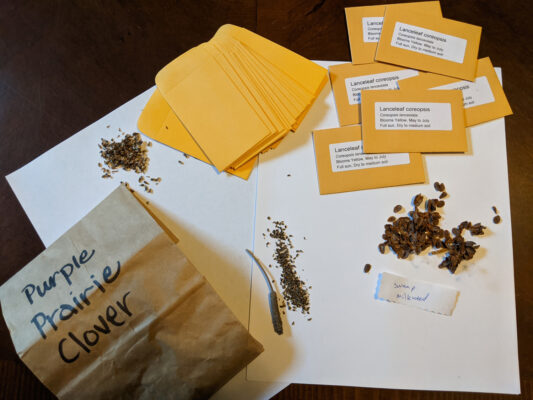by Besa Schweitzer
Wild Ones St. Louis Chapter Member
Visit her website: Besa Grows Wild
When I want to spread my love of native plants around, an easy way for me to do that is to give away seeds. I collect seeds in my own yard over the year as they ripen and store them in paper bags. (Collecting seeds is also a good way to control spread of some aggressive plants). On cold or rainy days I get out my seeds and package them up to give away.
Collecting
A reliable way to tell a seed is ripe is to watch for the birds eating them. Ripe seeds will turn a dark color, pods will split, and fluff will happen. When collecting seed my preferred method is to place a bucket under the plant and tip or rub the seeds into the bucket. Seeds that are more determined to attach to the plant can be clipped off and crushed to break them apart from the plant.
Cleaning
Bugs like seed heads and usually I accidentally collect a few beetles and spiders. If I set the seeds out in a tray in the sun for an hour usually most of the critters take off. Seeds that end up mixed with a bunch of plant debris can be separated by sifting them in front of a fan so the lighter material blows away. Seeds with fluff like asters and goldenrod can be placed in a paper bag and shook up really well. The seeds will break from the fluff and fall to the bottom of the bag. It is difficult to separate out every last seed and I don’t worry if I don’t get every one. Some seeds will end up in the compost pile where they return to the garden.
Packaging
Label seeds immediately after collecting with the name and date. I always think I will remember what I collected but seeds are hard to tell apart and get mixed up easily. Keep labels with the seeds throughout the cleaning and packaging process to avoid confusion, wasted time, and embarrassment if something is mislabeled. Throw out seeds that are more than a year old, they might germinate poorly. Fresh seed will perform better and the goal is to get others hooked on native plants by making it easy.
I like to make my seed packets from coin envelopes that I order in packs of 500. I print the labels on address stickers with the plant details. Ideally including the common and scientific name, preferred habitat, bloom color and time, growing tips, and the year collected. I put about a teaspoon of seeds in each envelope which seems like a small amount but can be hundreds of seeds. If I have all my material laid out I can put together about 100 packets while watching a webinar.
Germination
Not all seeds will germinate easily, but many can either be sown directly in the bed where they are to grow or can be grown in pots. Growing in pots is a good method for a beginning gardener to learn what the seedling plant looks like, often very different from the adult. Direct sowing outdoors is a good method for the lazy gardener who might forget to water. Keep seedlings moist after germination to allow them to develop a sturdy root system before transplanting.
Easy to collect and grow
Here is a list of easy to collect and grow plants that can be directly sown in the ground. These plants are relatively well-behaved garden stars. Since they are plants that are easy to grow from seed they will spread in the garden and may become weeds in other areas. I keep these plants in check by collecting the seeds to give away. Any baby plants that sprout in areas I don’t want them I dig up and give to friends in the spring.
Wild columbine (Aquilegia canadensis)
Aromatic aster (Symphyotrichum oblongifolium)
Lanceleaf coreopsis (Coreopsis lanceolata)
Purple prairie clover (Dalea purpurea)
Wild bergamot (Monarda fistulosa)
Black-eyed Susan (Rudbeckia hirta)
Royal catchfly (Silene regia)
Cliff goldenrod (Solidago drummondii)





Great article Besa. I miss you
Some of my favorites:
SILPHIUM
BIG AND LITTLE BLUESTEM
COREOPSIS TRIPTENSIS? TALL COREOPSIS
RATTLESNAKE MASTER
BAPTISIA AND SENNA
SHRUBBY ST. JOHN’S WORT
ILLINOIS BUNDLEFLOWER
MAXIMILLIAN SUNFLOWER
EASTERN GAMA GRASS
ETC.
N.E. ASTERS SPREAD ON OWN, PRETTY MUCH
ETC.